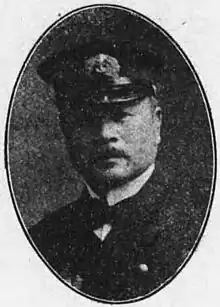Yoshioka Hansaku
Yoshioka Hansaku (吉岡 範策, 8 May 1869 – 19 March 1930) was an vice admiral of the Imperial Japanese Navy.
Yoshioka Hansaku 吉岡 範策 | |
|---|---|
 Portrait of Yoshioka Hansaku | |
| Born | 8 May 1869 Higo Domain, Japan |
| Died | 19 March 1930 (aged 60) Tokyo, Japan |
| Allegiance | |
| Service/ | |
| Years of service | 1891–1924 |
| Rank | |
| Commands held | Naniwa |
| Battles/wars | First Sino-Japanese War Russo-Japanese War World War I |
Career
Born in 8 May 1869 in Higo Province (now Uki, Kumamoto Prefecture), the eldest son of a Higo samurai. In 1891, he graduated from the 18th term of the Imperial Japanese Naval Academy and became an ensign in the navy. During the First Sino-Japanese War, he served under Captain Heihachirō Tōgō as a squadron officer on the protected cruiser Naniwa. After serving as a navigation officer on the Fuji, he graduated from the Naval War College in 1901. In 1904, he became a major in the Navy and participated in the Russo-Japanese War as chief gunnery officer of the Second Fleet flagship Izumo in the Battle of Tsushima. In 1912, he became a member of the Grand Mourning Ceremony Navy Affairs Committee and a naval drill judge.
After serving as captain of the Hashidate, he was appointed assistant captain of the Asama on 23 August 1914. This was the day that Japan declared war against the German Empire, and Yoshioka went to war in World War I. Initially, he was part of the 1st Southward Expeditionary Force led by Yamaya Tanin to search for the German fleet led by Maximilian von Spee, and engaged in the occupation of the South Seas Mandate.[1] Next, he was part of the US-led branch led by Keizaburo Moriyama to protect trade from South America to North America. However, 31 January 1915 off Mexico, the ship struck an uncharted rock at the entrance to the bay.[2]
In December 1915 (1915), he became captain of the Tsukuba. She was commissioned by the Taishō Emperor at a fleet review held the following year.[3] After serving as captain of the Kongō, he was promoted to Rear Admiral in 1917 and became the second director of the Naval Education Headquarters. In 1 December 1919, he became Chief of Staff of the First Fleet, the following year he became Chief of Staff of the Combined Fleet, in 1921 he was promoted to Vice Admiral and Director of the Naval Gunnery School and in 1923, served as a member of the Naval General Staff Council. He became a reserve officer in 1924.
As a vice admiral, he was awarded the Order of the Golden Kite, 4th class. He was also known as the "God of Gunnery". He died in 1930. His commandment name was Seichuin-den Atsuo Tanchu Daishi and his grave is in Ogawa, Uki, Kumamoto Prefecture.
References
- 『海戦史に学ぶ』「ドイツ太平洋艦隊との海戦
- 『浅間、日進座礁査問付査定書(2)』
- 『拝謁名簿』
Bibliography
- Nichigai Associates (2007). Kumamoto-Ken Jinbutsu Jinzai Jōhō Risuto.
- Kaigun Rekishi Hozon-Kai. Nippon Kaigun-Shi. Vol. 9. Dai-Ichi Hoki.
- Misao, Toyama (ed.). Rikukaigun Shōkan Jinji Sōran Kaigun-Hen. Fuyōshobō.
- Nomura, Minoru (1994). Kaisen-Shi Ni Manabu. Bunshun Bunko. ISBN 4-16-742802-4.